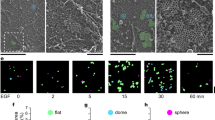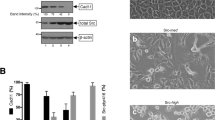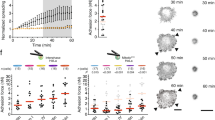Abstract
Src kinases are activated and relocalize to the cytoplasm during mitosis, but their mitotic function has remained elusive. We describe here a novel mitotic substrate of src kinases. Trask (transmembrane and associated with src kinases) is a 140 kDa type I transmembrane glycoprotein unrelated to currently known protein families. Src kinases phosphorylate Trask in vitro and mediate its mitotic hyperphosphorylation in vivo. Trask associates with both yes and src, is localized to the cell membrane during interphase, and undergoes cytoplasmic relocalization during mitosis. Overexpression of Trask leads to cell rounding and a loss of adhesion phenotype. Consistent with a function in cell adhesion, Trask interacts with a number of adhesion and matrix proteins including cadherins, syndecans, and the membrane-type serine protease 1 (MT-SP1), and is proteolytically cleaved by MT-SP1. Trask is unique among cell adhesion molecules in that it is under cell cycle regulation and thus links src kinases with the mitotic regulation of cell adhesion. This suggests a potential pathway by which hyperactive src kinases in tumors can deregulate adhesion signaling and mediate the metastatic phenotype.
This is a preview of subscription content, access via your institution
Access options
Subscribe to this journal
Receive 50 print issues and online access
$259.00 per year
only $5.18 per issue
Buy this article
- Purchase on Springer Link
- Instant access to full article PDF
Prices may be subject to local taxes which are calculated during checkout






Similar content being viewed by others
References
Bagrodia S, Chackalaparampil I, Kmiecik TE and Shalloway D . (1991). Nature, 349, 172–175.
Bagrodia S, Laudano AP and Shalloway D . (1994). J. Biol. Chem., 269, 10247–10251.
Bhatt AS, Takeuchi T, Ylstra B, Ginzinger D, Albertson D, Shuman MA and Craik CS . (2003). Biol. Chem., 384, 257–266.
Boyer B, Bourgeois Y and Poupon MF . (2002). Oncogene, 21, 2347–2356.
Brown TA, Yang TM, Zaitsevskaia T, Xia Y, Dunn CA, Sigle RO, Knudsen B and Carter WG . (2004). J. Biol. Chem., 279, 14772–14783.
Cartwright CA, Kamps MP, Meisler AI, Pipas JM and Eckhart W . (1989). J. Clin. Invest., 83, 2025–2033.
Chackalaparampil I and Shalloway D . (1988). Cell, 52, 801–810.
David-Pfeuty T and Nouvian-Dooghe Y . (1990). J. Cell Biol., 111, 3097–3116.
Erdjument-Bromage H, Lui M, Lacomis L, Grewal A, Annan RS, MacNulty DE, Carr SA and Tempst P . (1998). J. Chromatogr., 826, 167–181.
Erpel T and Courtneidge SA . (1995). Curr. Opin. Cell Biol., 7, 176–182.
Fumagalli S, Totty NF, Hsuan JJ and Courtneidge SA . (1994). Nature, 368, 871–874.
Geromanos S, Freckleton G and Tempst P . (2000). Anal. Chem., 72, 777–790.
Guy CT, Muthuswamy SK, Cardiff RD, Soriano P and Muller WJ . (1994). Genes Dev., 8, 23–32.
Hooper JD, Zijlstra A, Aimes RT, Liang H, Claassen GF, Tarin D, Testa JE and Quigley JP . (2003). Oncogene, 22, 1783–1794.
Irby RB and Yeatman TJ . (2000). Oncogene, 19, 5636–5642.
Irby RBM and Fujita DJJ . (1999). Nat. Genet., 21, 187–190.
Jones RJ, Avizienyte E, Wyke AW, Owens DW, Brunton VG and Frame MC . (2002). Br. J. Cancer, 87, 1128–1135.
Jove R and Hanafusa H . (1987). Annu. Rev. Cell Biol., 3, 31–56.
Kaplan KB, Swedlow JR, Varmus HE and Morgan DO . (1992). J. Cell Biol., 118, 321–333.
Kozak M . (1987). Nucleic Acids Res., 15, 8125–8148 (abstract).
Kraker AJ, Hartl BG, Amar A, Barvian MR, Showalter HD and Moore CW . (2000). Biochem. Pharmacol., 60, 885–898.
Lee SL, Dickson RB and Lin CY . (2000). J. Biol. Chem., 275, 36720–36725.
Lukong KE and Richard S . (2003). Biochim. Biophys. Acta, 1653, 73–86.
Mamidipudi V, Zhang J, Lee KC and Cartwright CA . (2004). Mol. Cell. Biol., 24, 6788–6798.
Mao W, Irby R, Coppola D, Fu L, Wloch M, Turner J, Yu H, Garcia R, Jove R and Yeatman TJ . (1997). Oncogene, 15, 3083–3090.
Mizenina OA and Moasser MM . (2004). Cell Cycle, 3, 796–803.
Moasser MM, Srethapakdi M, Sachar KS, Kraker AJ and Rosen N . (1999). Cancer Res., 59, 6145–6152.
Mustelin T and Hunter T . (2002). Science's STKE [Electronic Resource]: Signal Transduction Knowledge Environ., 115, PE3.
Ottenhoff-Kalff AE, Rijksen G, van Beurden EA, Hennipman A, Michels AA and Staal GE . (1992). Cancer Res., 52, 4773–4778.
Park J and Cartwright CA . (1995). Mol. Cell. Biol., 15, 2374–2382.
Park J, Meisler AI and Cartwright CA . (1993). Oncogene, 8, 2627–2635.
Pena SV, Melhem MF, Meisler AI and Cartwright CA . (1995). Gastroenterology, 108, 117–124.
Roche S, Fumagalli S and Courtneidge SA . (1995a). Science, 269, 1567–1569.
Roche S, Koegl M, Barone MV, Roussel MF and Courtneidge SA . (1995b). Mol. Cell. Biol., 15, 1102–1109.
Rosen N, Bolen JB, Schwartz AM, Cohen P, DeSeau V and Israel MA . (1986). J. Biol. Chem., 261, 13754–13759.
Santin AD, Zhan F, Bellone S, Palmieri M, Cane S, Bignotti E, Anfossi S, Gokden M, Dunn D, Roman JJ, O’Brien TJ, Tian E, Cannon MJ, Shaughnessy Jr J and Pecorelli S . (2004). Int. J. Cancer, 112, 14–25.
Scherl-Mostageer M, Sommergruber W, Abseher R, Hauptmann R, Ambros P and Schweifer N . (2001). Oncogene, 20, 4402–4408.
Sugimura M, Kobayashi K, Sagae S, Nishioka Y, Ishioka S, Terasawa K, Tokino T and Kudo R . (2000). Jpn. J. Cancer Res., 91, 395–398.
Takeuchi T, Harris JL, Huang W, Yan KW, Coughlin SR and Craik CS . (2000). J. Biol. Chem., 275, 26333–26342.
Tatsuka M, Ota T, Yamagishi N, Kashihara Y, Wada M, Matsuda N, Mitsui H, Seiki M and Odashima S . (1996). Mol. Carcinogen., 15, 300–308.
Taylor SJ, Anafi M, Pawson T and Shalloway D . (1995). J. Biol. Chem., 270, 10120–10124.
Taylor SJ and Shalloway D . (1994). Nature, 368, 867–871.
Wang LL, Richard S and Shaw AS . (1995). J. Biol. Chem., 270, 2010–2013.
Webster MA, Cardiff RD and Muller WJ . (1995). Proc. Natl. Acad. Sci. USA, 92, 7849–7853.
Acknowledgements
We thank Lisa Denzin and Marilyn Resh for helpful discussions and Sami Mahrus and Chris Farady for reagents and helpful discussion regarding this manuscript. This work was supported by the American Cancer Society RSG-02-139-01-CDD (MMM) and NIH CA 72006 (CSC). ASB is supported by the NIH medical scientist training grant and a fellowship from the ARCS foundation.
Author information
Authors and Affiliations
Corresponding author
Additional information
The Trask sequence has been deposited in the NCBI database with Genebank accession #AY167484
Rights and permissions
About this article
Cite this article
Bhatt, A., Erdjument-Bromage, H., Tempst, P. et al. Adhesion signaling by a novel mitotic substrate of src kinases. Oncogene 24, 5333–5343 (2005). https://doi.org/10.1038/sj.onc.1208582
Received:
Revised:
Accepted:
Published:
Issue Date:
DOI: https://doi.org/10.1038/sj.onc.1208582
Keywords
This article is cited by
-
CDCP1 expression is frequently increased in aggressive urothelial carcinoma and promotes urothelial tumor progression
Scientific Reports (2023)
-
SRC kinase-mediated signaling pathways and targeted therapies in breast cancer
Breast Cancer Research (2022)
-
Substrate-biased activity-based probes identify proteases that cleave receptor CDCP1
Nature Chemical Biology (2021)
-
The PDGFRβ/ERK1/2 pathway regulates CDCP1 expression in triple-negative breast cancer
BMC Cancer (2018)
-
Novel millimeter-wave-based method for in situ cell isolation and other applications
Scientific Reports (2018)



